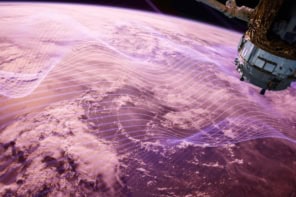
If humans released enough engineered nanoparticles into the atmosphere of Mars, the planet could become more than 30 K warmer – enough to support some forms of microbial life. This finding is based on theoretical calculations by researchers in the US, and it suggests that “terraforming” Mars to support temperatures that allow for liquid water may not be as difficult as previously thought.
“Our finding represents a significant leap forward in our ability to modify the Martian environment,” says team member Edwin Kite, a planetary scientist at the University of Chicago.
Today, Mars is far too cold for life as we know it to thrive there. But it may not have always been this way. Indeed, streams may have flowed on the red planet as recently as 600 000 years ago. The idea of returning Mars to this former, warmer state – terraforming – has long kindled imaginations, and scientists have proposed several ways of doing it.
One possibility would be to increase the levels of artificial greenhouse gases, such as chlorofluorocarbons, in Mars’ currently thin atmosphere. However, this would require volatilizing roughly 100 000 megatons of fluorine, an element that is scarce on the red planet’s surface. This means that essentially all the fluorine required would need to be transported to Mars from somewhere else – something that is not really feasible.
An alternative would be to use materials already present on Mars’ surface, such as those in aerosolized dust. Natural Martian dust is mainly made of iron-rich minerals distributed in particles roughly 1.5 microns in radius, which are easily lofted to altitudes of 60 km and more. In its current form, this dust actually lowers daytime surface temperatures by attenuating infrared solar radiation. A modified form of dust might, however, experience different interactions. Could this modified dust make the planet warmer?
Nanoparticles designed to trap escaping heat and scatter sunlight
In a proof-of-concept study, Kite and colleagues at the University of Chicago, the University of Central Florida and Northwestern University analysed the atmospheric effects of nanoparticles shaped like short rods about nine microns long, which is about the same size as commercially available glitter. These particles have an aspect ratio of around 60:1, and Kite says they could be made from readily-available Martian materials such as iron or aluminium.
Calculations using finite-difference time domains showed that such nanorods, which are randomly oriented due to Brownian motion, would strongly scatter and absorb upwelling thermal infrared radiation in certain spectral windows. The nanorods would also scatter sunlight down towards the surface, adding to the warming, and would settle out of the atmosphere and onto the Martian surface more than 10 times more slowly than natural dust. This implies that, once airborne, the nanorods would be lofted to high altitudes and remain in the atmosphere for long periods.
More efficient than previous Martian warming proposals
These factors give the nanorod idea several advantages over comparable schemes, Kite says. “Our approach is over 5000 times more efficient than previous global warming proposals (on a per-unit-mass-in-the-atmosphere basis) because it uses much less mass of material to achieve significant warming,” he tells Physics World. “Previous schemes required importing large amounts of gases from Earth or mining rare Martian resources, [but] we find that nanoparticles can achieve similar warming with a much smaller total mass.”
However, Kite stresses that the comparison only applies to approaches that aim to warm Mars’ atmosphere on a global scale. Other approaches, including one developed by researchers at Harvard University and NASA’s Jet Propulsion Laboratory (JPL) that uses silica aerogels, would be better suited for warming the atmosphere locally, he says, adding that a recent workshop on Mars terraforming provides additional context.

Mars has frost-covered mountains at its equator but no lakes at its poles
While the team’s research is theoretical, Kite believes it opens new avenues for exploring planetary climate modification. It could inform future Mars exploration or even long-term plans for making Mars more habitable for microbes and plants. Extensive further research would be required, however, before any practical efforts in this direction could see the light of day. In particular, more work is needed to assess the very long-term sustainability of a warmed Mars. “Atmospheric escape to space would take at least 300 million years to deplete the atmosphere at the present-day rate,” he observes. “And nanoparticle warming, by itself, is not sufficient to make the planet’s surface habitable again either.”
Kite and colleagues are now studying the effects of particles of different shapes and compositions, including very small carbon nanoparticles such as graphene nanodisks. They report their present work in Science Advances.



